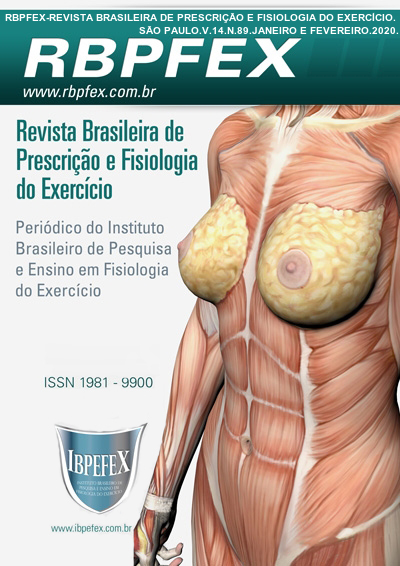Effects of a training on the physical fitness of rio de janeiro city handball schools
Abstract
Introduction: handball is a collective sport, characterized by great quantity and variety in its movements, ball manipulation and interaction with other athletes. Physical activity is one of the most important prerequisites for the healthy growth and development of children and adolescents, as well as for the establishment of an active lifestyle during adulthood. The aim of the present study was to analyze the levels of physical fitness before and after a proposed training of students from the city of Rio do Janeiro who practice handball, after 15 weeks of training. Materials and Methods: the population consisted of schoolchildren aged 12 to 15 years, belonging to elementary school, a school in the Municipal Education Network in the city of Rio de Janeiro-RJ. There was approval by the ethics and research committee. For the statistical analysis, the Shapiro Wilk test was used to verify the normality of the data. When the data were parametric, the “t†test was used for paired samples, and for non-parametric data, the Wilcoxon test was used. Results: when comparing the pre-test with the post-test, the 2 (two) variables showed a statistically significant difference. Conclusion: the specific practices of sports related to handball sport, presented as being important for improving the motor skills of students in the age group studied.
References
Böheme, M. T. S. Aptidão física: aspectos teóricos. Revista Paulista de Educação Física. São Paulo. Vol. 7. 1993. p.52-55.
Borges, A. F. Avaliação e Comparação de Indicadores Antropométricos e Neuromusculares de Jovens Escolares do Ensino Fundamental do Interior Paulista. Dissertação de Mestrado em Educação Física. Programa de Pós-Graduação em Educação Física da Universidade Metodista de Piracicaba. Piracicaba.2008.
Braga, F.; Generosi, R. A.; Garlipp, D. C.; Gaya, A. Programas de Treinamento de Força para Escolares sem uso de Equipamentos. Revista Eletrônica da Ulbra São Jerônimo. Vol.3. 2008.
Caputo, E. L.; Silva, M. C.; Correia, P. V.; Pereira, W. E.; Vaz, V. P. Análise dos componentes de aptidão física de adolescentes praticantes de handebol. Lecturas Educación Física y Deportes. Ano14. Num. 133. 2009. p. 1-1.
Faigenbaum, A.D. Comparisonof 1 and 2 days per week of strength training in children. Res Q Exerc Sport. Vol. 73. 2002. p. 416-424.
Gaya, A.; Silva, G.Manual de aplicação de medidas e testes, normas e critérios de avaliação. Projeto Esporte Brasil. 2007. p. 1-27.
Machado Filho, R. Aptidão física de meninos escolares da cidade de Guarulhos-SP praticantes de atividades relacionadas ao Futsal após 15 semanas de treinamento. Revista Brasileira de Futsal e Futebol. São Paulo. Vol. 4. Num. 11. 2012. p. 11-16.
Machado Filho, R. Comparação de variáveis antropométrica de escolares da rede pública do estado de São Paulo praticantes de handebol e atividade física geral após três meses de treinamento. Revista Brasileira de Prescrição e Fisiologia do Exercício. São Paulo. Vol. 7. Num. 37. 2013. p. 71-77.
Machado Filho, R.; Pellegrinotti, I. L. Crescimento e desenvolvimento das capacidades motoras de escolares das 5as e das 6as séries praticantes de aulas esportivas e atividade física geral. Revista Brasileira de Prescrição e Fisiologia do Exercício. São Paulo. Vol. 7. Num. 40. 2013. p. 388-397.
Marins, J. C. B.; Giannichi, R. S. Avaliação e prescrição de atividade física. 3ª edição. Rio de Janeiro.Shape.2003.
Oliveira, A. R.; Gallagher, J. D. Treinamento de força muscular em crianças: novas tendências. Revista Brasileira de Atividade Física e Saúde. Vol. 2. Num. 3. 1997. p. 80-90.
Vargas, R. P.; Santi, H.; Duarte, M.; Cunha Junior, A. T. Característica antropométricas, fisiológicas e qualidades físicas básicas de atletas de handebol feminino. Revista Brasileira de Prescrição e Fisiologia do Exercício. São Paulo. Vol. 4. Num. 22. 2010. p. 352-362.
Copyright (c) 2021 Brazilian Journal of Exercise Physiology and Prescription (RBPFEX)

This work is licensed under a Creative Commons Attribution-NonCommercial 4.0 International License.
Authors who publish in this journal agree to the following terms:
- Authors retain the copyright and grant the journal the right of first publication, with work simultaneously licensed under the Creative Commons Attribution License BY-NC which allows the sharing of the work with acknowledgment of the authorship of the work and initial publication in this journal.
- Authors are authorized to enter into additional contracts separately for non-exclusive distribution of the version of the work published in this journal (eg, publishing in institutional repository or book chapter), with acknowledgment of authorship and initial publication in this journal.
- Authors are allowed and encouraged to post and distribute their work online (eg, in institutional repositories or on their personal page) at any point before or during the editorial process, as this can bring about productive change as well as increase impact and impact. citation of published work (See The Effect of Free Access).






